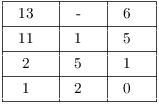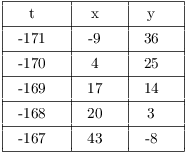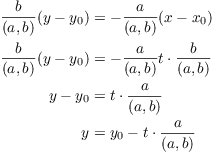A Diophantine problem is one in which the solutions are required to be integers. Abusing terminology, I'll refer to Diophantine equations, meaning equations which are to be solved over the integers.
For example, the equation ![]() has many solutions over the reals.
Here's a solution:
has many solutions over the reals.
Here's a solution:
![]()
However, this equation has no nonzero integer solutions. This is a special case of Fermat's Last Theorem.
On the other hand, the following equation has infinitely many integer solutions:
![]()
![]() and
and ![]() are examples of solutions.
are examples of solutions.
In this section, I'll look at equations like the last one. They're called linear Diophantine equations.
Theorem. Let ![]() . Consider the Diophantine
equation
. Consider the Diophantine
equation
![]()
(a) If ![]() , there are no
solutions.
, there are no
solutions.
(b) If ![]() , there are infinitely
many solutions of the form
, there are infinitely
many solutions of the form
![]()
Here ![]() is a particular solution, and
is a particular solution, and ![]() .
.
If you've had a course in differential equations, you may have seen
something like this. ![]() and
and
![]() give a general solution to the
homogeneous equation
give a general solution to the
homogeneous equation
![]()
![]() is a particular solution to
is a particular solution to ![]() . Their sum gives a general
solution to the given (nonhomogeneous) equation.
. Their sum gives a general
solution to the given (nonhomogeneous) equation.
Before I give the proof, I'll give some examples, and also discuss
the three variable equation ![]() .
.
Example. Solve ![]() .
.
Since ![]() , there are infinitely
many solutions. Divide the equation by 3 to get
, there are infinitely
many solutions. Divide the equation by 3 to get
![]()
By inspection, ![]() and
and ![]() is a particular solution. Hence, the
general solution is
is a particular solution. Hence, the
general solution is
![]()
For example, setting ![]() produces the
solution
produces the
solution ![]() ,
, ![]() .
.![]()
In general, you may not be able to see a particular solution by inspection. In that case, you can use the Extended Euclidean algorithm to generate one. We'll see how to do this in examples that follow.
Example. Solve ![]() .
.
Since ![]() , the equation has no
solutions.
, the equation has no
solutions.![]()
Example. Find all the solutions ![]() to the following Diophantine equation for
which x and y are both positive.
to the following Diophantine equation for
which x and y are both positive.
![]()
![]() , so there are solutions.
, so there are solutions.
It is too hard to guess a particular solution, so I'll use the Extended Euclidean algorithm:

![]()
Matching this with the given equation ![]() , I see that
, I see that ![]() is a particular
solution. The general solution is
is a particular
solution. The general solution is
![]()
I want solutions for which x and y are both positive. So
![]()
![]()
The integers which satisfy both of these inequalities are ![]() . Here are the values of x and y:
. Here are the values of x and y:

The solutions are ![]() ,
, ![]() , and
, and ![]() .
.![]()
The requirement that the solutions be positive can come up in real-world problems.
Example. Phoebe buys large shirts for $18 each and small shirts for $11 each. The shirts cost a total of $1188. What is the smallest total number of shirts she could have bought?
Let x be the number of large shirts and let y be the number of small shirts. Then
![]()
Since ![]() , there are
solutions.
, there are
solutions.
I'll use the Extended Euclidean algorithm to get a particular solution:

![]()
![]() and
and ![]() is a particular solution. The general
solution is
is a particular solution. The general
solution is
![]()
Since the number of shirts can't be negative, I have ![]() and
and ![]() .
.
![]()
![]()
Thus, ![]() .
.
The total number of shirts is
![]()
For ![]() , this is smallest for
, this is smallest for ![]() , which gives
, which gives
![]()
She bought 66 large shirts, no small shirts, and a total of 66
shirts.![]()
Consider a 3-variable equation
![]()
The equation has solutions if and only if ![]() . If it has solutions, there will
be infinitely many, determined by two integer parameters.
. If it has solutions, there will
be infinitely many, determined by two integer parameters.
You can solve a 3-variable equation by reducing it to a 2-variable equation. Group the first two terms and factor out the greatest common divisor of their coefficients. Introduce a new variable, defining it to be what is left after the greatest common divisor is factored out. The new equation is a 2-variable Diophantine equation, which you can solve using the method described earlier.
Example. Find the general solution to the following Diophantine equation.
![]()
![]()
Let ![]() .
.
![]()
![]() and
and ![]() is a particular solution. So
is a particular solution. So
![]()
Then
![]()
![]() and
and ![]() is a particular solution. The
general solution is
is a particular solution. The
general solution is

A general linear Diophantine equation has the form
![]()
There are solutions if ![]() .
If there is a solution, it will in general have
.
If there is a solution, it will in general have ![]() parameters --- exactly as you'd expect from
linear algebra.
parameters --- exactly as you'd expect from
linear algebra.
Here's the proof of the theorem for the two-variable case.
Proof. (two variable case) Consider the linear Diophantine equation
![]()
Case 1. Suppose ![]() . If x and y are solutions to the
equation, then
. If x and y are solutions to the
equation, then
![]()
This contradiction shows that there cannot be a solution.
Case 2. Suppose ![]() . Write
. Write ![]() for
for ![]() . There are integers m and n such
that
. There are integers m and n such
that
![]()
Then
![]()
Hence, ![]() ,
, ![]() , is a solution.
, is a solution.
Suppose ![]() ,
, ![]() , is a particular solution. Then
, is a particular solution. Then
![]()
This proves that ![]() ,
,
![]() is a solution for
every
is a solution for
every ![]() .
.
Finally, I want to show that every solution has this form. Suppose
then that ![]() is a solution. Then
is a solution. Then ![]() and
and ![]() imply
imply
![]()
Therefore,
![]()
![]()
Now ![]() divides the left side, so it
divides the right side. However,
divides the left side, so it
divides the right side. However, ![]() . Therefore,
. Therefore,
![]()
Thus,
![]()
Substitute ![]() back into the last x-y equation above:
back into the last x-y equation above:

Thus,
![]()
Copyright 2019 by Bruce Ikenaga